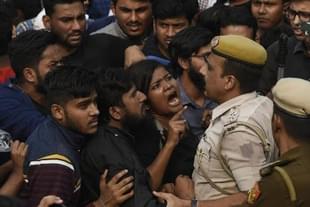Politics
Creating Alternative Histories And Narratives Is The Only Way To Counter Left’s Destructive Activism On Campus
Akhilesh Pathak
Jan 09, 2020, 01:48 PM | Updated 01:47 PM IST
Save & read from anywhere!
Bookmark stories for easy access on any device or the Swarajya app.


“The recruiting grounds for revolutionaries, ranging from nonviolent “propagandists” to the most extreme terrorists, were not Russia’s factories or villages but her universities.”
This is how Richard Pipes (2003) in his book, Communism: A History mixes brevity with clarity in bringing out the essence of student politics in erstwhile Soviet Russia.
In light of the new era inaugurated in our times with the oft-discussed incident of anti-India sloganeering in Jawaharlal Nehru University (JNU) on 9 February 2016 with its continuation leading to the recent violence in JNU, one cannot ignore the newly-emerged culture of non-cooperation and outright rejectionism on Indian campuses.
However, one must bear in mind that student politics in all its forms is not dangerous. Rather, it is so when drawing from extremist ideologies of all shades.
Moreover, never before was student politics so significant in India’s national politics which is, of course, made ever more possible owing to the strategic use of social media in our time. It has verily established the status of student politics as what could be called the ‘fifth column’ in Indian politics.
In tracing the roots of most tactics employed by mainstream student organisations in today’s India, one is led back to the Magna Carta of modern student politics documented and published by the American student organisation, SDS (Students for a Democratic Society).
Therefore, an analysis of the document entitled, “Port Huron Statement” in the context of the developments taking place in today’s India does not seem out of place.
The Port Huron Statement
An analysis of the “Port Huron Statement” (1962) drafted by Tom Hayden for SDS must be carried out in order to uncover the roots of why universities in our times have turned into battlegrounds for ideological warfare relegating their prime objective of learning and teaching to the backseat.
In the concluding passage of the statement, one finds a section captioned, “The University And Social Change”. The section while acknowledging the role of the university as a powerful tool to churn, polish, and develop novel ideas looks to capitalise on its potential to nurture not ideas but “ideology”.
The first point of the section reads thus:
1. Any new left in America must be, in large measure, a left with real intellectual skills, committed to deliberativeness, honesty, reflection as working tools. The university permits the political life to be an adjunct to the academic one, and action to be informed by reason.
Without being misled by the language that is seemingly innocuous when looked at superficially, one must not miss the use of the term, ‘New Left’ that was already in vogue in those days and had embraced the doctrine of “cultural Marxism”, of which, Maoism could, inarguably, be taken to be a strand.
The New Left had as its focus the agenda of creating multiple schisms within the countries of the third world with the single motive of spreading communism to these places. One of the chief proponents of this project was an American sociologist named C Wright Mills, who published his ideas as Letter to the New Left in 1960.
What were the means by which to accomplish the task? The above agenda point is unequivocal on the issue. It seeks an alliance of the ‘academic’ and the ‘political’.
Maybe we have been too late to realise, but this doctrine could be considered to have an everlasting impact on academics across the globe.
Incidents such as students refusing to learn Aristotelian logic and Kantian epistemology because they were White men, and violent protests against the author of The Bell Curve, Charles Murray at Middlebury College in May 2017 are nothing but signs of the triumph of the kind of ‘sectarianism’ and ‘tribalism’ that this academic-political activism has propagated.
In India, we have had our share of intolerance and ‘deplatforming’ when Swami Ramdev was prevented from delivering a lecture on Vedanta scheduled to be held in JNU in December 2015.
Having got a feel of the appalling trend that has plagued the global academic scenario, one must also pay attention to the third point of SDS’s mission statement which is as follows:
3. A new left must consist of younger people who matured in the post-war world, and partially be directed to the recruitment of younger people. The university is the obvious beginning point.
The point seems to be based on some foundational questions like who shall form the ranks of what seemed to be a mission to politicise academics.
Probably they are young minds that happen to visit the universities. But, what kind of young students were at target that seemed suitable to take the politics of the New Left forward?
The answer came up in the next point (point # 4) of the statement:
4. A new left must include liberals and socialists, the former for their relevance, the latter for their sense of thoroughgoing reforms in the system. The university is a more sensible place than a political party for these two traditions to discuss their differences and look for political synthesis.
Thus, the university was to lose its academic fervour in order to transform itself into a space where liberals and socialists could discuss and sort out their political issues.
Academic freedom and neutrality would find it hard to jostle for space on university campuses under such a setting. Can we now make out why most university campuses have lost the sense of tolerance for any other stream of thought?
It’s largely because of this sinister design carried forward by the New Left. But that should not be as disturbing as the next point which says:
5. A new left must start controversy across the land, if national policies and national apathy are to be reversed. The ideal university is a community of controversy, within itself and in its effects on communities beyond.
Once again, a caveat must be issued here for not being carried away by the use of the word, ‘apathy’ in the sentence which is nothing but ‘disagreement with Communist ethos’.
The SDS project looked to deliberately convert complexities into issues giving rise to conditions that get the masses to rally behind a particular solution to the issues without ever pondering on the rightfulness of the solution.
That said, how was the SDS supposed to achieve its goals? It clearly outlined its design in the penultimate paragraph of the Port Huron Statement:
To turn these possibilities into realities will involve national efforts at university reform by an alliance of students and faculty. They must wrest control of the educational process from the administrative bureaucracy. They must legitimize the right to speak and act in public, partisan ways. They must make fraternal and functional contact with allies in labor, civil rights, and other liberal forces outside the campus. They must import major public issues into the curriculum — research and teaching on problems of war and peace is an outstanding example. They must make debate and controversy, not dull pedantic cant, the common style of the educational life.
To ‘make debate and controversy’ and to act in ‘partisan’ ways are now the prime task of academics, a line of action which is more political than academic.
Thus, without doubt, though formulated to suit the post-war American context, the ideological basis of what we witness across campuses in this country today was laid down about half a century ago by the American student group known as SDS.
What needs to be done?
As a nation, coming to terms with the situation quite early is the key to our success in the struggle.
The postmodern-leftist logic is our biggest enemy in the realm of this war of ideas.
The postmodernist logic that is founded on subjectivity and narratives rejecting any and all forms of objective and scientific truths must be scrutinised on the basis of our lived experience instead of borrowing it ‘as-is’ from postmodernist thinkers such as Foucault, Derrida, Lyotard etc.
Experience goes on to teach us that there are spheres of objective reality and subjective experience.
For example, we may attempt to call fire by the name, “water”, but if we put our fingers into it, we are bound to have our skin burnt and reduced to ashes.
It has nothing to do with our subjective experience of fire.
It is an objective fact. Searching for subjectivity in the same example, one can easily understand that it is a matter of common experience that the sense of burning or the heat that one experiences from the fire is, of course, a subjective experience.
If Jack and Jill both burn their fingers, the heat that Jack actually feels will definitely not be identical to Jill’s feeling. Thus, both subjective and objective side of the world must be lived and understood before living in a world of ‘relativism’ guided by nothing save narratives.
Finally, one must also take the narrative built and popularised by the present Indian academia with caution.
The designs of the New Left alluded to in the preceding sections does not let other evidence and narratives come to the fore.
Although deliberately hidden and left undisclosed, there is ample evidence to expose the inhuman and brutal nature of communist regimes that have ever existed as part of some bizarre political experiment, one of the recent examples being the case of Venezuela.
There is a need to revisit historical evidence and search for fresh evidence aided by more advanced methodology that we have at our disposal.
There is definitely a scope for the emergence of alternative histories and narratives, perhaps the only way out that could rescue us from this terrible condition of “all activism, and no academics” in Indian universities.
It is true that sensationalism has always seemed attractive to the young mind as argued by Charles Homer Haskins in his book, The Rise of Universities (1957), and hence there is always a greater probability of the youthful imagination falling for romanticism, which is seemingly a clarion call to the young people to overthrow all rules and norms of society.
But, one must act cautiously before choosing to throw the baby along with the bath water. What purpose would a world of chaos serve if the goal is to usher in a ‘good’ society?
If the current trend in Indian academics is left unchecked, it could be a nightmarish experience for most of us in the future, a trepidation which is quite similar to the thought expressed by Malcolm Muggeridge in the following remark:
The most encouraging thing about the Soviet regime was its failure. If it had succeeded . . . I would have known that there were no limits to the extent to which human beings could be terrorised and enslaved.
Akhilesh Pathak is a Ph.D. scholar at the Jawaharlal Nehru University’s Centre for the Study of Social Systems.





